boohoo group Bundle
How Well Does Boohoo Group Know Its Customers?
In the fast-paced world of fashion retail, understanding your customer is paramount. For boohoo group SWOT Analysis, a deep dive into customer demographics and target markets is crucial for sustained success. This exploration will uncover the strategies Boohoo Group employs to identify and cater to its diverse consumer base, ensuring its continued relevance in a competitive market.
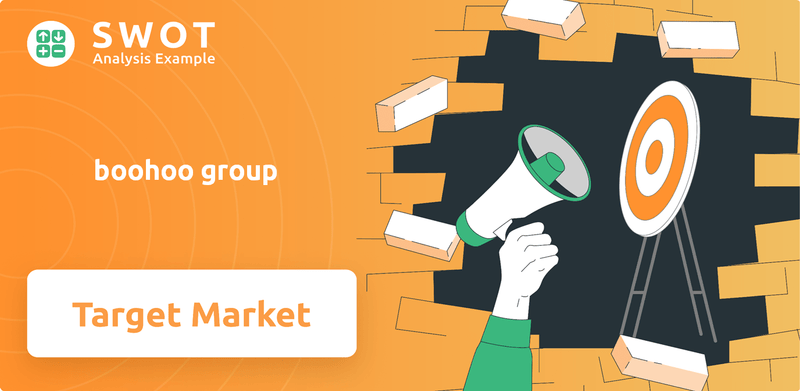
The ability to adapt to changing consumer preferences and market dynamics is key to success in the fashion industry. This analysis will examine the customer demographics and target market of boohoo group, including their buying behavior analysis, preferred clothing styles, and online shopping habits. We'll delve into how Boohoo Group uses data to refine its customer segmentation strategies, manage its customer acquisition cost, and ultimately, maximize its customer lifetime value in the ever-evolving fashion retail landscape, supported by thorough market analysis.
Who Are boohoo group’s Main Customers?
Understanding the Competitors Landscape of boohoo group begins with a deep dive into its primary customer segments. The company, operating primarily in the business-to-consumer (B2C) market, focuses on a broad age range, generally targeting individuals aged 16 to 40 years old. However, each brand within the group caters to slightly different segments within this demographic.
The flagship brand, traditionally known as boohoo, often targets the younger end of this spectrum, specifically those aged 16 to 24. PrettyLittleThing, another key brand, usually appeals to a slightly older demographic, typically 16 to 30 years old. Nasty Gal, on the other hand, targets a more fashion-forward consumer, often in the 18 to 35 age range. The acquisitions of Karen Millen and Coast have expanded the customer base to include an older and more affluent demographic, typically 30 to 50+, seeking premium attire.
These varying customer demographics are characterized by different income levels, with the core boohoo customer often being budget-conscious. Education levels also vary across the brands, from those still in secondary education to university graduates and young professionals. While the primary target has historically been women, the company has expanded into menswear, indicating a strategic shift to capture a broader market. The largest share of revenue comes from the younger, fast-fashion segments, particularly boohoo and PrettyLittleThing.
The boohoo group's primary target market is women aged 16 to 40, but the company has expanded into menswear. The flagship boohoo brand focuses on the 16 to 24 age group, while PrettyLittleThing caters to 16 to 30 year olds. Nasty Gal targets 18 to 35 year olds, and Karen Millen and Coast target a 30-50+ demographic.
Customer demographics vary in income, with the boohoo customer often being budget-conscious. Education levels range from secondary school to university graduates and young professionals. The company's brands cater to diverse customer segments.
The acquisition of premium brands reflects a strategic shift to diversify revenue streams. Market research indicates a desire for more diverse offerings and a maturing customer base. The company is actively working to capture growth in higher-value segments.
Boohoo Group's financial reports highlight the performance of its core brands. These brands significantly contribute to overall sales. The company's strategic focus includes adapting to changing consumer preferences.
The customer demographics of the boohoo group are primarily defined by age, income, and fashion preferences. A detailed market analysis reveals that the company's brands cater to varying consumer profiles, from budget-conscious students to fashion-forward young professionals. The company's success depends on understanding and adapting to these diverse needs.
- The boohoo brand targets a younger demographic, focusing on affordable, trend-driven fashion.
- PrettyLittleThing appeals to a slightly older audience with more glamorous styles.
- Nasty Gal caters to a fashion-forward consumer.
- Karen Millen and Coast target an older, more affluent demographic.
boohoo group SWOT Analysis
- Complete SWOT Breakdown
- Fully Customizable
- Editable in Excel & Word
- Professional Formatting
- Investor-Ready Format
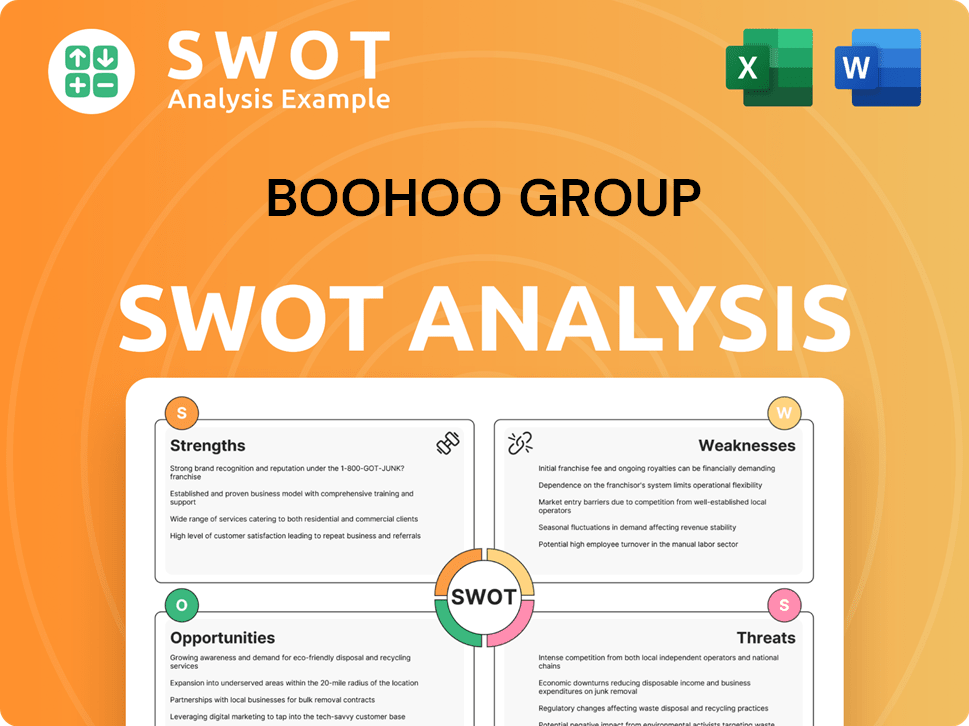
What Do boohoo group’s Customers Want?
Understanding the customer needs and preferences is crucial for the success of the boohoo group. The company's strategy revolves around meeting the demands of its target market by offering trendy, affordable fashion. This involves a deep dive into what drives their customers' purchasing decisions and how the company can best cater to those needs.
The primary drivers for customers of the boohoo group are affordability, the latest trends, and a wide selection of items. The company's success is closely tied to its ability to provide these elements consistently. The customer base is heavily influenced by social media trends, which means the company must adapt quickly to changing styles and preferences.
The customer base of the boohoo group is driven by a desire for self-expression and keeping up with current fashion trends. They need affordable clothing for various occasions, and they aspire to achieve a certain look or lifestyle, often influenced by social media influencers. The company addresses the pain point of expensive fashion by offering trendy items at lower price points.
Customers are drawn to affordable fashion options. The boohoo group's ability to offer trendy items at lower price points is a key factor in attracting and retaining customers. This focus on value for money is central to their business model.
Staying current with the latest fashion trends is a significant motivator. The company's success is linked to its ability to quickly adapt to changing styles. They monitor social media and influencer marketing to stay ahead of the curve.
Customers appreciate a wide variety of choices. The boohoo group offers an extensive range of products to cater to different tastes and preferences. This variety keeps customers engaged and encourages repeat purchases.
Social media trends and influencer marketing significantly impact purchasing decisions. The company leverages these platforms to showcase new arrivals and engage with customers. This helps in understanding and responding to market trends.
Customers seek rapid access to new styles. The company's agile supply chain allows for quick production and offering of similar items. This speed is crucial in a fast-paced fashion environment.
A seamless online shopping experience is essential. Factors such as ease of browsing and purchasing are key. The company focuses on a mobile-first customer experience for convenience.
The boohoo group's customers are primarily driven by the need for affordable, trend-driven fashion and a wide variety of choices. Their preferences are heavily influenced by social media and influencer marketing, leading to a demand for frequent new arrivals and the ability to replicate viral styles quickly.
- Affordability: Customers prioritize value for money.
- Trendiness: Staying up-to-date with the latest styles is crucial.
- Variety: A wide selection of products is essential.
- Social Media Influence: Purchasing decisions are influenced by social media trends and influencers.
- Speed of Delivery: Quick access to new styles is important.
- Online Experience: A seamless and user-friendly online shopping experience is expected.
boohoo group PESTLE Analysis
- Covers All 6 PESTLE Categories
- No Research Needed – Save Hours of Work
- Built by Experts, Trusted by Consultants
- Instant Download, Ready to Use
- 100% Editable, Fully Customizable
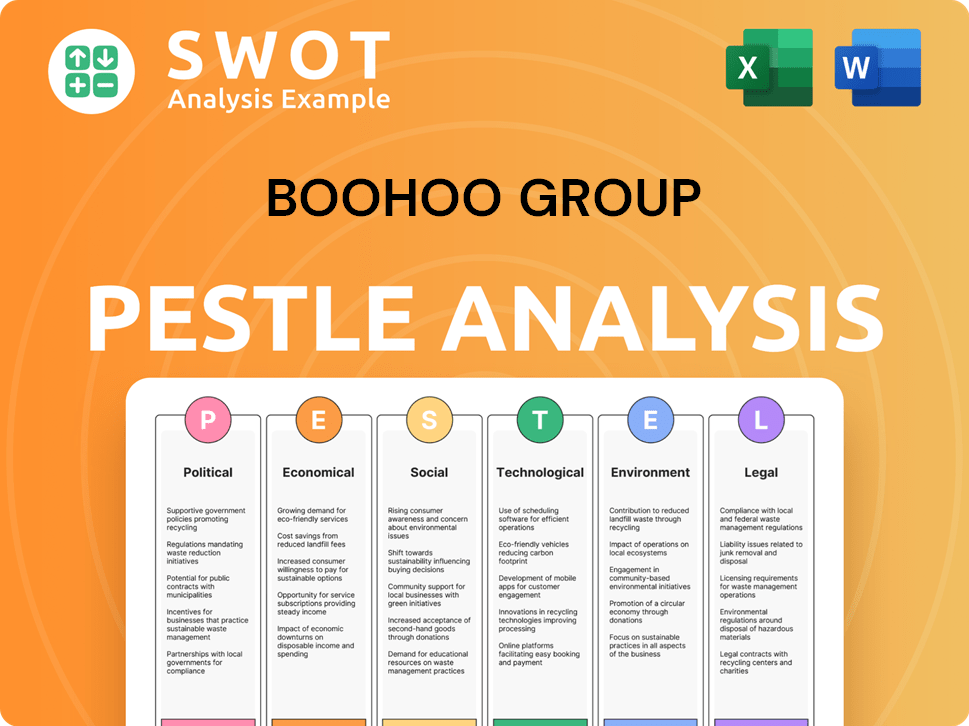
Where does boohoo group operate?
The Growth Strategy of boohoo group involves a significant global presence, extending far beyond its UK origins. The company strategically targets various international markets, adapting its approach to suit regional preferences and consumer behaviors. This global expansion is a key element of its business model, driving growth and market share.
Geographically, the company's main areas of operation include the United States, Australia, and several European countries. These regions represent significant markets where the company has established a strong foothold. The company continues to explore new opportunities and strengthen its presence in existing markets.
The company's approach to different regions involves tailoring its offerings to local tastes and preferences. This includes localized websites, currency options, and marketing campaigns. The company's annual reports provide insights into the geographic distribution of sales, highlighting its global reach.
A detailed market analysis reveals that the company's success is closely tied to its ability to understand and cater to diverse customer demographics. The company focuses on fast fashion and affordable trends, which appeals to a wide range of consumers globally. The company's data-driven approach helps in understanding customer preferences and buying behaviors.
The company's customer demographics are diverse, but it primarily targets young adults and those interested in fashion. The company's customer base spans various age groups, income levels, and lifestyle characteristics. The company's ability to adapt its products and marketing to suit different demographics is a key factor in its global success.
The company's target market consists of fashion-conscious consumers who seek affordable and trendy clothing. The company's marketing strategies are tailored to reach this demographic through various online channels. The company's focus on digital marketing and social media engagement is critical for reaching its target audience.
The company heavily relies on online shopping as its primary sales channel. Its customers exhibit strong online shopping habits, with a preference for convenience and accessibility. The company's user-friendly website and mobile app enhance the online shopping experience.
The company employs several strategies to maintain its global presence and appeal to a diverse customer base. These strategies include localized marketing campaigns, tailored product assortments, and efficient supply chain management.
- Customer Segmentation: The company segments its customer base to better understand and cater to specific needs.
- Digital Marketing: The company leverages digital marketing and social media to engage with its target audience.
- Supply Chain: The company's efficient supply chain enables it to quickly adapt to changing fashion trends.
- Brand Perception: The company focuses on maintaining a positive brand perception through consistent messaging and quality products.
boohoo group Business Model Canvas
- Complete 9-Block Business Model Canvas
- Effortlessly Communicate Your Business Strategy
- Investor-Ready BMC Format
- 100% Editable and Customizable
- Clear and Structured Layout
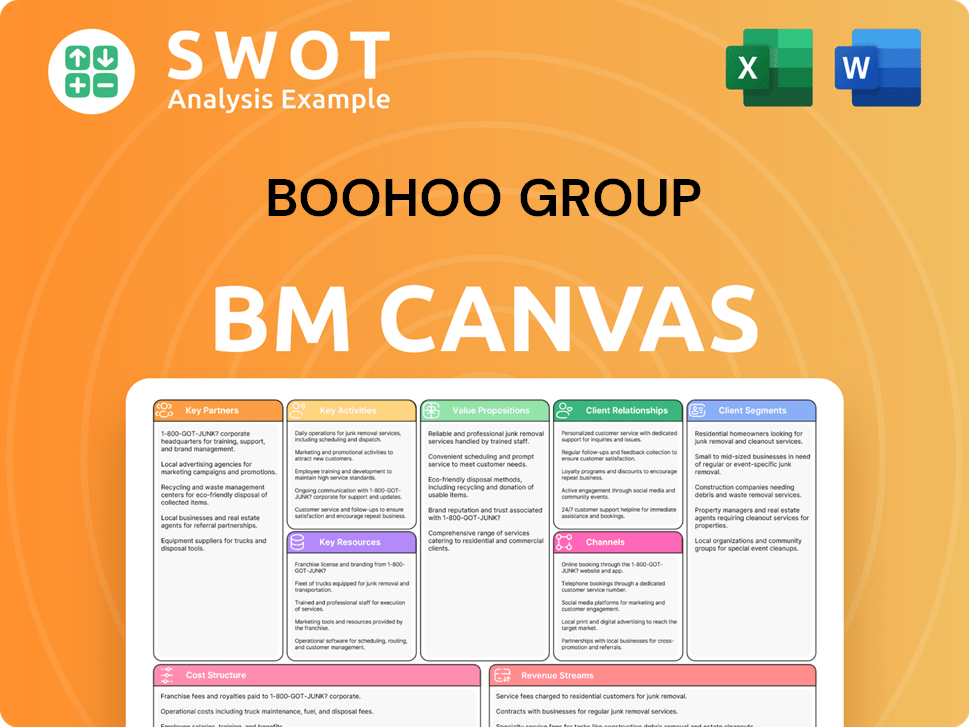
How Does boohoo group Win & Keep Customers?
The customer acquisition and retention strategies of the company are heavily reliant on digital channels, particularly social media. They use a multi-faceted approach that includes influencer collaborations, paid search advertising, and email marketing. Effective use of these channels helps to drive traffic and sales, which is crucial in the competitive fashion retail market.
Frequent promotions, discount codes, and limited-time offers are key sales tactics. This creates a sense of urgency and encourages immediate purchases. Personalized experiences, such as website recommendations based on browsing history, also play a role in enhancing the customer journey. These strategies are designed to attract and retain customers in a fast-paced online environment.
Customer data and CRM systems are essential for targeting campaigns effectively. By analyzing purchasing patterns, browsing behavior, and demographic information, the company segments its audience and delivers tailored marketing messages. This data-driven approach allows for more efficient allocation of marketing resources and improved customer engagement. Understanding the Owners & Shareholders of boohoo group is also important for understanding the company's strategic direction.
Social media marketing is a core strategy, utilizing platforms like Instagram, TikTok, and Facebook. The company uses engaging content and targeted advertising to reach its customer demographics. Successful campaigns often involve viral challenges and collaborations with influencers to generate buzz and drive traffic.
Collaborations with influencers, ranging from mega-influencers to micro-influencers, are a significant part of their strategy. This helps in reaching diverse segments of the target market. The use of varied influencers allows the company to connect with different consumer profiles and preferences.
Frequent promotions, discount codes, and limited-time offers are used to drive immediate purchases. These tactics create a sense of urgency and encourage customers to buy. This approach is common in the fast fashion industry to stimulate sales.
Personalized website recommendations based on browsing history and past purchases are implemented. This enhances the customer experience and encourages repeat purchases. Tailoring the shopping experience to individual preferences is a key retention strategy.
The company's approach involves a combination of digital marketing, sales tactics, and customer experience enhancements. They focus on creating urgency, offering personalized experiences, and leveraging data to target campaigns effectively.
- Customer Segmentation: Analyzing purchasing patterns, browsing behavior, and demographic information to deliver tailored marketing messages.
- Data-Driven Marketing: Utilizing customer data and CRM systems to target campaigns effectively.
- Retention Initiatives: Offering exclusive app-only deals and early access to sales for loyal customers.
- Rapid Fulfillment: Emphasizing fast delivery to meet customer expectations.
- Competitive Pricing: Offering competitive prices to attract and retain customers.
boohoo group Porter's Five Forces Analysis
- Covers All 5 Competitive Forces in Detail
- Structured for Consultants, Students, and Founders
- 100% Editable in Microsoft Word & Excel
- Instant Digital Download – Use Immediately
- Compatible with Mac & PC – Fully Unlocked
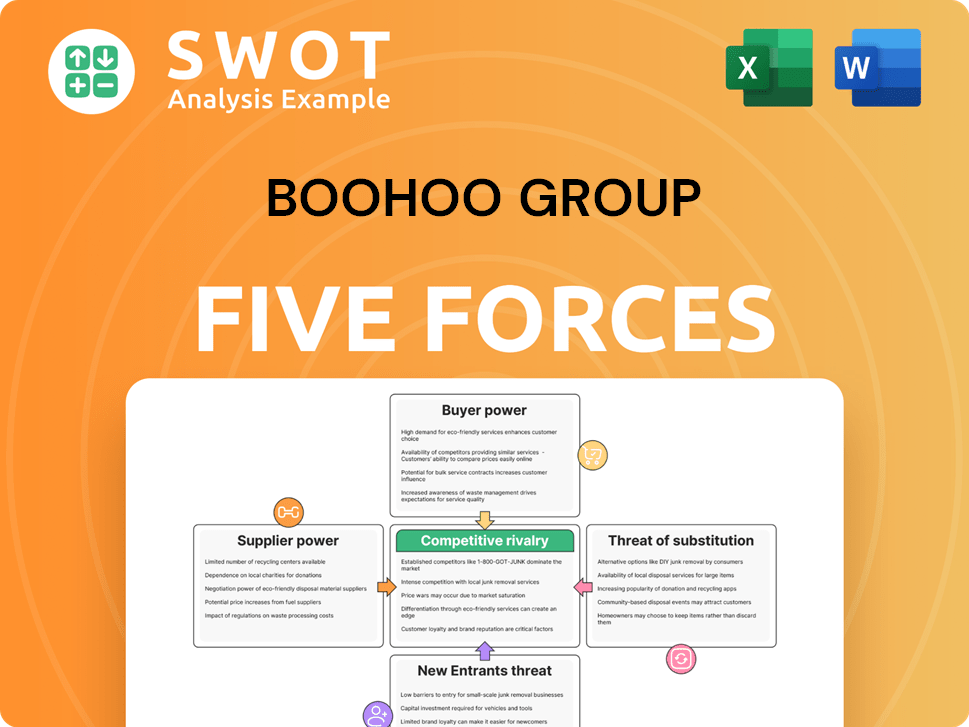
Related Blogs
- What are Mission Vision & Core Values of boohoo group Company?
- What is Competitive Landscape of boohoo group Company?
- What is Growth Strategy and Future Prospects of boohoo group Company?
- How Does boohoo group Company Work?
- What is Sales and Marketing Strategy of boohoo group Company?
- What is Brief History of boohoo group Company?
- Who Owns boohoo group Company?
Disclaimer
All information, articles, and product details provided on this website are for general informational and educational purposes only. We do not claim any ownership over, nor do we intend to infringe upon, any trademarks, copyrights, logos, brand names, or other intellectual property mentioned or depicted on this site. Such intellectual property remains the property of its respective owners, and any references here are made solely for identification or informational purposes, without implying any affiliation, endorsement, or partnership.
We make no representations or warranties, express or implied, regarding the accuracy, completeness, or suitability of any content or products presented. Nothing on this website should be construed as legal, tax, investment, financial, medical, or other professional advice. In addition, no part of this site—including articles or product references—constitutes a solicitation, recommendation, endorsement, advertisement, or offer to buy or sell any securities, franchises, or other financial instruments, particularly in jurisdictions where such activity would be unlawful.
All content is of a general nature and may not address the specific circumstances of any individual or entity. It is not a substitute for professional advice or services. Any actions you take based on the information provided here are strictly at your own risk. You accept full responsibility for any decisions or outcomes arising from your use of this website and agree to release us from any liability in connection with your use of, or reliance upon, the content or products found herein.